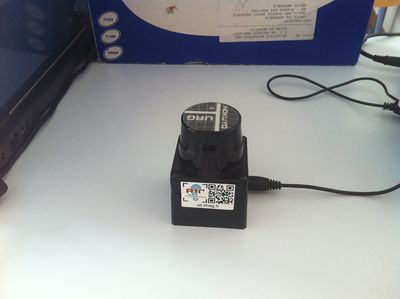Difference between revisions of "Hokuyo URG-04LX-UG01"
| Line 1: | Line 1: | ||
| ⚫ | |||
[[Image:Wifibot_hokuyo_lidar.jpg|200px|thumb|right|Hokuyo URG-04LX-UG01 installed on the WifiBot]] |
[[Image:Wifibot_hokuyo_lidar.jpg|200px|thumb|right|Hokuyo URG-04LX-UG01 installed on the WifiBot]] |
||
| Line 14: | Line 15: | ||
==Use the Lidar with [[Robot Operating System|ROS]]== |
==Use the Lidar with [[Robot Operating System|ROS]]== |
||
| ⚫ | |||
A dedicated [[Robot Operating System|ROS]] node exists. To use it, a tutorial is available on [[Robot Operating System|ROS]] [http://www.ros.org/wiki/hokuyo_node/Tutorials/UsingTheHokuyoNode website]. If you are using ROS on a recent environment (Ubuntu version >= 12.10 & ROS version >= Groovy) some changes have to be made. |
A dedicated [[Robot Operating System|ROS]] node exists. To use it, a tutorial is available on [[Robot Operating System|ROS]] [http://www.ros.org/wiki/hokuyo_node/Tutorials/UsingTheHokuyoNode website]. If you are using ROS on a recent environment (Ubuntu version >= 12.10 & ROS version >= Groovy) some changes have to be made. |
||
Latest revision as of 10:56, 18 April 2013
LIDaR (LIght Detection and Ranging or Laser Imaging Detection and Ranging) is an optical remote sensing technology that can measure the distance to, or other properties of, targets by illuminating the target with laser light and analyzing the backscattered light. [Wikipédia]
http://www.robotshop.com/eu/capteur-distance-laser-urg-04lx-ug01-hokuyo-eu-2.html
http://www.hokuyo-aut.jp/02sensor/07scanner/urg_04lx_ug01.html
Hokuyo URG Programming Ressources http://www.hokuyo-aut.jp/02sensor/07scanner/download/urg_programs_en/
This lidar sensor provides the SCIP (Sensor CommunIcation Protocol Specification) 2.0 API.
Use the Lidar with ROS
A dedicated ROS node exists. To use it, a tutorial is available on ROS website. If you are using ROS on a recent environment (Ubuntu version >= 12.10 & ROS version >= Groovy) some changes have to be made.
- For the installation, point 1.1 of the tutorial. You get the hokuyo_node package by the command:
sudo apt-get install ros-groovy-laser-drivers - For viewing the data, point 1.7 of the tutorial. You monitor the data into the rviz tool with these commands:
rosrun rviz rviz -lthen, add a new LaserScan Interface and fill the following informations :
Fixed frame: /laser
Target frame: /laser
Topic: /scan
Now you can see the Lidar working ;)
In the following photo, we test the lidar by creating an almost 3 sides-square shape. You can see that is been monitored on rviz, with a hole on the right side (the empty space between the Lidar box and the computer screen).


